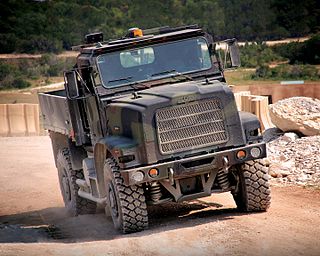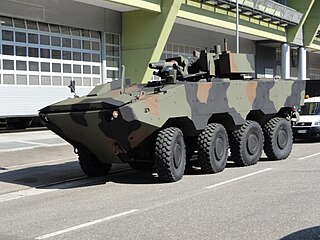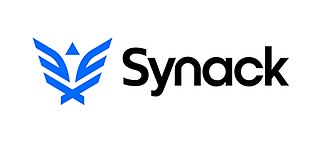
The Defense Advanced Research Projects Agency (DARPA) is a research and development agency of the United States Department of Defense responsible for the development of emerging technologies for use by the military.
Electronic design automation (EDA), also referred to as electronic computer-aided design (ECAD), is a category of software tools for designing electronic systems such as integrated circuits and printed circuit boards. The tools work together in a design flow that chip designers use to design and analyze entire semiconductor chips. Since a modern semiconductor chip can have billions of components, EDA tools are essential for their design; this article in particular describes EDA specifically with respect to integrated circuits (ICs).
The DARPA Grand Challenge is a prize competition for American autonomous vehicles, funded by the Defense Advanced Research Projects Agency, the most prominent research organization of the United States Department of Defense. Congress has authorized DARPA to award cash prizes to further DARPA's mission to sponsor revolutionary, high-payoff research that bridges the gap between fundamental discoveries and military use. The initial DARPA Grand Challenge was created to spur the development of technologies needed to create the first fully autonomous ground vehicles capable of completing a substantial off-road course within a limited time. The third event, the DARPA Urban Challenge extended the initial Challenge to autonomous operation in a mock urban environment. The most recent Challenge, the 2012 DARPA Robotics Challenge, focused on autonomous emergency-maintenance robots.
Automotive engineering, along with aerospace engineering and naval architecture, is a branch of vehicle engineering, incorporating elements of mechanical, electrical, electronic, software, and safety engineering as applied to the design, manufacture and operation of motorcycles, automobiles, and trucks and their respective engineering subsystems. It also includes modification of vehicles. Manufacturing domain deals with the creation and assembling the whole parts of automobiles is also included in it. The automotive engineering field is research -intensive and involves direct application of mathematical models and formulas. The study of automotive engineering is to design, develop, fabricate, and test vehicles or vehicle components from the concept stage to production stage. Production, development, and manufacturing are the three major functions in this field.
Fabless manufacturing is the design and sale of hardware devices and semiconductor chips while outsourcing their fabrication to a specialized manufacturer called a semiconductor foundry. Foundries are typically, but not exclusively, located in the United States, People's Republic of China and Taiwan. Fabless companies can benefit from lower capital costs while concentrating their research and development resources on the end market. Some fabless companies and pure play foundries may offer integrated-circuit design services to third parties.

The Gama Goat is a six-wheel drive semi-amphibious off-road vehicle originally developed for use by the US military in the Vietnam War. The Goat uses an articulated chassis, so that from distance it appears to be a four-wheel drive vehicle pulling a two-wheel trailer, but it is a single six-wheel vehicle with a four-wheel steering arrangement with the front and rear wheels turning in opposite directions. It was famous for its ability to travel over exceptionally rough and muddy terrain.

The DARPA Falcon Project is a two-part joint project between the Defense Advanced Research Projects Agency (DARPA) and the United States Air Force (USAF) and is part of Prompt Global Strike. One part of the program aims to develop a reusable, rapid-strike Hypersonic Weapon System (HWS), now retitled the Hypersonic Cruise Vehicle (HCV), and the other is for the development of a launch system capable of accelerating an HCV to cruise speeds, as well as launching small satellites into Earth orbit. This two-part program was announced in 2003 and continued into 2006.

The Boeing A160 Hummingbird is an unmanned aerial vehicle (UAV) helicopter. Its design incorporates many new technologies never before used in helicopters, allowing for greater endurance and altitude than any helicopter currently in operation.

TerraMax is the trademark for autonomous/unmanned ground vehicle technology developed by Oshkosh Defense. Primary military uses for the technology are seen as reconnaissance missions and freight transport in high-risk areas so freeing soldiers from possible attacks, ambushes or the threat of mines and IEDs. The technology could also be used in civilian settings, such as autonomous snow clearing at airports.
The Humvee replacement process, undertaken by the U.S. military, was an effort to replace the current AM General Humvee multi-purpose motor vehicle. The Humvee had evolved several times since its introduction in 1984, and is now used in tactical roles for which it was not originally intended. The U.S. military pursued several initiatives to replace it, both in the short and long term. The short-term replacement efforts utilize commercial off-the-shelf (COTS) vehicles, while the long-term efforts focused on building requirements for the Humvee replacement and technology research and evaluation in the form of various prototype vehicles.
GlobalFoundries Inc. (GF) is a U.S.-based semiconductor manufacturer headquartered in Malta, New York, United States and the only one in the world with a truly global independent manufacturing footprint. GlobalFoundries was created by the divestiture of the manufacturing arm of Advanced Micro Devices (AMD). Global Foundries is owned by Mubadala Investment Company.

The Ground Combat Vehicle (GCV) was the United States Army's replacement program for armored fighting vehicles in Armored and Stryker brigade combat teams. The GCV was organized under the Follow On Incremental Capabilities Package of the BCT Modernization program. The first variant of the vehicle was to be prototyped in 2015 and fielded by 2017. It replaced the canceled Future Combat Systems, manned ground vehicles program. The Ground Combat Vehicle program was cancelled in February 2014. Its replacement was Next generation combat vehicle.

The Ground Combat Infantry Fighting Vehicle was an infantry fighting vehicle being developed for the U.S. Army. The program originated as the lead vehicle of the U.S. Army's Ground Combat Vehicle program coordinated by TACOM and spawned a parallel program coordinated by DARPA. The purpose of the program was to replace existing armored personnel carriers and infantry fighting vehicles in U.S. Army service. The DARPA project aimed to have the vehicle designed by 2015. Derivatives of the vehicle based on a common chassis—such as tanks and ambulances—were expected to be manufactured. It replaced the previous attempt at a next-generation infantry transport, the XM1206 Infantry Carrier Vehicle. The Ground Combat Vehicle program was cancelled in February 2014.

The Aerial Reconfigurable Embedded System (ARES) was a concept for an unmanned VTOL flight module that can transport various payloads. The concept started as the TX (Transformer) in 2009 for a terrain-independent transportation system centered on a ground vehicle that could be configured into a VTOL air vehicle and carry four troops. ARES' primary function was the same as TX, to use flight to avoid ground-based transportation threats like ambushes and IEDs for units that don't have helicopters for those missions. It was to be powered by twin tilting ducted fans and have its own power system, fuel, digital flight controls, and remote command-and-control interfaces. The flight module would have different detachable mission modules for specific purposes including cargo delivery, CASEVAC, and ISR. Up to 3,000 lb (1,400 kg) of payload would be carried by a module.

The Amphibious Combat Vehicle (ACV) is a program initiated by Marine Corps Systems Command to procure an amphibious assault vehicle for the United States Marine Corps to supplement and ultimately replace the aging Assault Amphibious Vehicle (AAV). The program replaces the Expeditionary Fighting Vehicle (EFV) program canceled in 2011. Originally a plan to develop a high-water-speed vehicle, the program has expanded into a multi-phased approach to procure and develop several types of amphibious-capable vehicles to address near and long-term requirements.

The Iveco SuperAV is an eight-wheel drive tactical vehicle developed by the Italian commercial vehicle company Iveco. A version made by BAE Systems was selected by the United States Marine Corps for the Amphibious Combat Vehicle program.
The Learning Applied to Ground Vehicles (LAGR) program, which ran from 2004 until 2008, had the goal of accelerating progress in autonomous, perception-based, off-road navigation in robotic unmanned ground vehicles (UGVs). LAGR was funded by DARPA, a research agency of the United States Department of Defense.
The Defense Advanced Research Projects Agency (DARPA) Ground X-Vehicle Technology (GXV-T) project is an effort to develop technologies and designs to create lighter future armored military vehicles.

Paul Eremenko is a Ukrainian American Innovator and Technology executive. He was formerly the Chief Technology Officer and Senior Vice President of United Technologies Corporation. Earlier, he served as the CTO of Airbus, and former CEO of Airbus Silicon Valley innovation center. He is a former Google executive and head of Google's Project Ara, an effort to create an open, modular smartphone platform. Eremenko was named one of the Top-10 Tech Leaders of 2015 in FORTUNE Magazine. Eremenko has also come out as a strong proponent of artificial intelligence and autonomy research, brushing away the growing chorus of concerns by many prominent technology and business leaders. Eremenko has cited his desire to build a starship as the motivation underpinning his career.

Synack is an American technology company based in Redwood City, California. The company combines AI and machine learning enabled security software with a crowdsourced network of white-hat hackers to help keep its customers secure. The software provides security testing through a SaaS platform to find exploitable vulnerabilities for reconnaissance. The company offers its services to government agencies and businesses in retail, healthcare and manufacturing industry.













